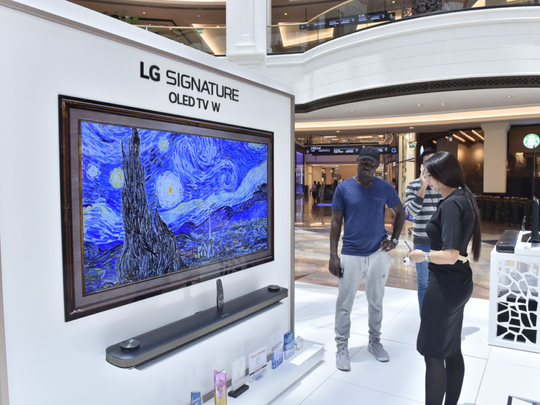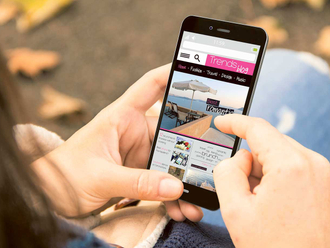
Dubai
LG is gearing up for the World Cup football fever by launching new OLED (organic light-emitting diode) TVs in a bid to gain an upper hand in the premium segment.
TV buying is expected to increase during the Fifa World Cup, which takes place between June 14 and July 15 in Russia. Four Arab countries — Morocco, Tunisia, Egypt and Saudi Arabia — are taking part this year.
The second largest TV manufacturer showcased four series — E8, B8, C8 and the flagship wallpaper design W8 Signature collection with artificial intelligence technology — on Thursday at Mall of the Emirates.
Boosun Kim, Head of TV sales at LG Electronics Gulf, told Gulf News that they have sold 1,000 OLED TVs in the UAE last year and expects a 100 per cent year-on-year growth in OLED TV sales this year.
He said that people are looking at bigger screen sizes as World Cup nears, instead of 55 inches they are looking at 65 inches.
“LG has invested a lot in OLED technology and our focus is on OLED. The Signature series W8 has two sizes — 65 and 77 inches. With the Alpha 9 intelligent processor, the colours, sharpness and depth produce true-to-life images and with Dolby Vision and Dolby Atmos high dynamic range formats,” he said.
All the OLED TVs come in three sizes — 55, 65 and 77-inches.
He added that LG TVs with AI ThinQ have the Google Assistant built-in which can help control smart home devices and change light settings and check room temperature, etc.
In 2019, Kim said that LG TVs with AI ThinQ will support the Arabic language.
Jeff Yang, the assistant research manager of WitsView, a division of market intelligence provider TrendForce, said that shipments of branded TV are expected to be 217 million units for 2018, a year-on-year growth of three per cent compared to 210.6 million units in 2017, a new low since 2014.
He said that OLED has become another word for premium products, especially after Sony joined the OLED bandwagon last year.
However, due to the limited supply of OLED TV panel in the short-term, he said the market share was about 0.7 per cent in 2017, most of the shipments coming from LG and Sony.
“With slightly increasing OLED panel supply, the market share of OLED TV is expected to grow to 1.2 per cent this year. More brands such as Panasonic and Philips will join the OLED TV market as well. The market share of LED TV is around 98-99 per cent,” he said.
Moreover, he said the stocking up demands brought by Fifa World Cup mainly come from markets in Europe, South America, Central Asia, and Africa, etc, so the time of transportation, local assembly, and distribution must be taken into consideration.
Therefore, he said the stocking up demands are expected to increase the shipments by 12.6 per cent (YOY) in the first quarter rather than in this quarter. Along with the start of World Cup in June, he said the stocking demand will be lower month by month, so the shipment growth will be about 6 per cent (YOY) in second quarter.
OLED features self-emission, and does not require backlight structure, so, he said that a OLED TV can be thinner with potentials in a constant optimisation of colour saturation and contrast. But the lifespan of organic material and burn-in remain issues for OLED TV.












